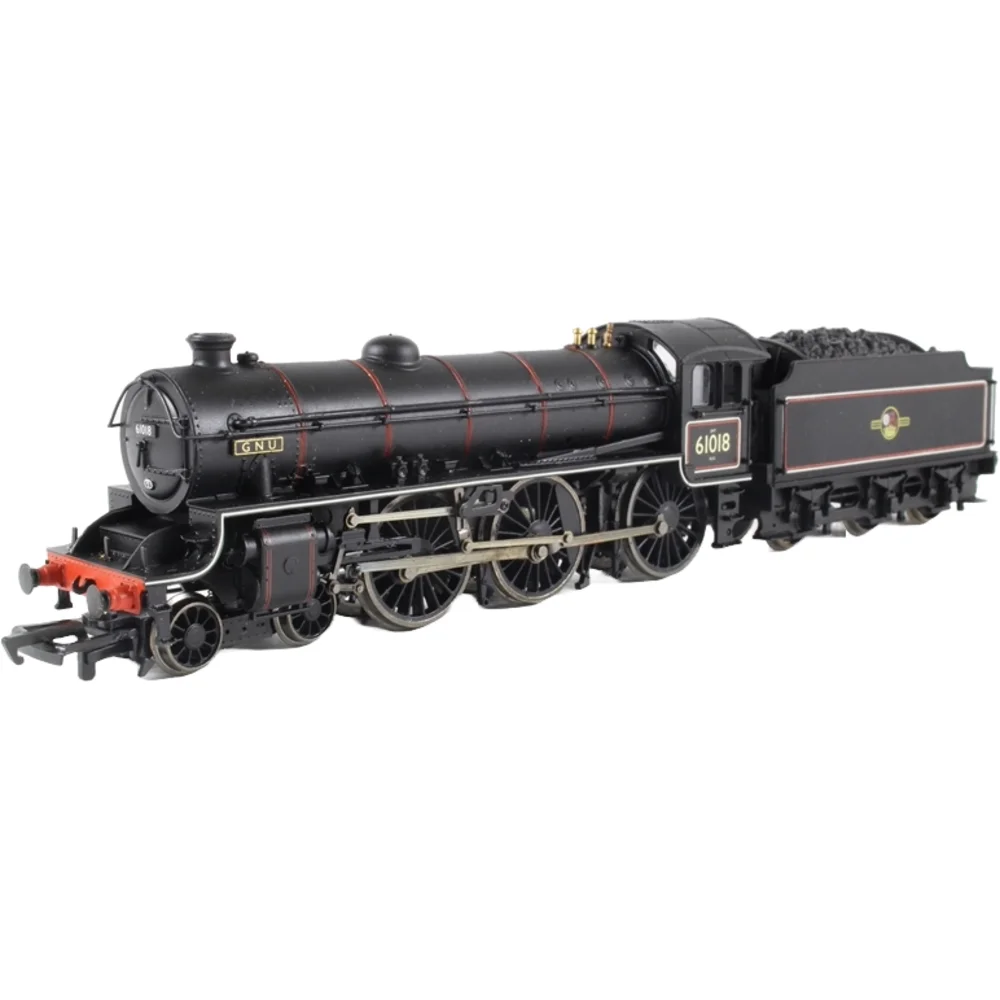Bachmann 31-710A
London & North Eastern Railway B1 61018 "GNU" British Railways Black with Late Crest
Tooling
The LNER B1 Class was a mixed-traffic 4-6-0 locomotive designed by Edward Thompson and introduced in 1942. The OO gauge model was originally developed by Mainline but completed and released by Replica Railways in 1987. When Bachmann entered the UK market in the early 1990s, they adopted this tooling, incorporating it into the Bachmann Branchline range from 1994. This tooling remained in production for many years and represents Bachmann’s early approach to British steam models before later retooling.
Tooling Features
- Scale: OO gauge (1:76).
- Construction: Plastic bodyshell mounted on a die-cast split chassis frame. Tender also plastic with integral detailing.
- Detailing: Moulded handrails, separate safety valves and whistles, cab glazing, and basic cab interior. Valve gear simplified compared to later toolings.
- Couplings: Standard tension-lock couplers; no NEM pockets on early releases.
Mechanical & Electrical
- Drive System: Split chassis design with a centrally mounted motor driving the coupled wheels via coupling rods.
- Motor: Bachmann can motor (Hong Kong manufacture).
- Minimum Radius: Recommended for second radius curves (approx. 438 mm).
- Lighting: None fitted.
- Weighting: Heavy die-cast chassis provided good traction for its era.
- Electrical Pickup: From driving wheels only; tender had no pickups.
DCC Capability
- Not DCC-ready. Conversion required hardwiring and insulating the split chassis, which was considered challenging for beginners.
Liveries Produced (1994 onwards)
Bachmann issued numerous authentic schemes using this tooling, including:
- LNER Apple Green and LNER Black (pre-nationalisation).
- BR Black (early and late crests).
- BR Green with early emblem.
- Special editions such as named locomotives “Springbok,” “Mayflower,” “Lord Burghley,” and weathered variants.
Reviews & Commentary
At launch, the model was praised for its accurate proportions and affordability. However, the split chassis system became a common criticism over time due to wear, electrical reliability issues, and difficulty of DCC conversion. Enthusiasts note that while the body detailing was acceptable for the late 1980s and early 1990s, it lacks the finesse of later Bachmann toolings. Despite these drawbacks, many examples remain in service on layouts thanks to their weight and reasonable haulage capability.
Interesting Notes
- The tooling originated from Mainline plans and was among the first British steam models produced by Kader for the UK market.
- Models were branded Bachmann but often carried Replica Railways packaging during the transition period.
- Wheelset and axle issues (swelling of nylon isolators) have been reported on older examples, requiring careful maintenance.
Class & Prototype
- Class: London & North Eastern Railway B1
- Traction: Steam
- Built: 1942-1952
- Total Built: 410
No prototype found.
Operator & Livery
- Operator: British Railways
- Livery: Black with Late Crest
British Railways transformed Britain's fragmented rail network into a unified national system following nationalisation on 1st January 1948. Created from the "Big Four" companies under the Transport Act 1947, BR operated most of Great Britain's railways until rebranding as British Rail in 1965, managing over 20,000 route miles and inheriting nearly 20,000 locomotives of diverse designs.
The organisation pioneered standardisation through its revolutionary BR Standard locomotive programme (1951-1960), producing 999 advanced steam engines under Robert Riddles' direction. These included the versatile Britannia Pacifics, mighty 9F freight engines, and mixed-traffic classes that incorporated the best features from all predecessor companies. The 1955 Modernisation Plan accelerated diesel and electric traction development, creating fascinating mixed-traction operations.
Notable achievements included establishing unified locomotive classification systems, introducing distinctive corporate liveries, and managing the complex transition from steam to modern traction. BR's six regional structure preserved operational diversity whilst enabling standardisation of practices, signalling, and rolling stock that had eluded private enterprise for over a century.
The BR era represents steam traction's final flowering alongside emerging diesel technology, creating unparalleled locomotive variety. Today, this heritage remains highly popular with railway enthusiasts through extensive preserved fleets, heritage railway operations, and comprehensive model ranges from manufacturers like Hornby, Bachmann, and Dapol, making BR subjects essential for authentic post-war British railway modelling across all scales.
British Railways' plain black livery remained the standard finish for freight and shunting locomotives from 1956 onwards, representing the most economical and practical scheme for inherently dirty industrial operations. Plain black locomotives retained red buffer beams and received white lettering in Gill Sans style, maintaining the utilitarian approach established in the early BR period. The livery was applied to a vast range of locomotive types, from powerful freight engines like the 9F class down to humble shunting locomotives and industrial engines working in goods yards, collieries, and freight terminals.
From 1956, these locomotives received the new "Lion and Crown" emblem (nicknamed the "Ferret and Dartboard"), a proper heraldic device featuring a rampant lion emerging from a crown and holding a spoked wheel, enclosed in a roundel with "British Railways" displayed on bars either side. Unlike earlier practice, the new emblem was positioned centrally on tender sides or tank sides without reference to axle boxes, following heraldic conventions with the lion facing left. This livery period coincided with increasing neglect as steam operations wound down, with locomotives often covered in layers of grime that obscured the paintwork and made the already austere black finish appear even more weathered. The plain black finish continued until individual locomotives were withdrawn from service, with many examples lasting into the final years of steam operation in 1968. For modellers, this livery represents the twilight of steam freight operations, capturing the workaday reality of British Railways' industrial locomotive fleet during the final phase of steam traction.
